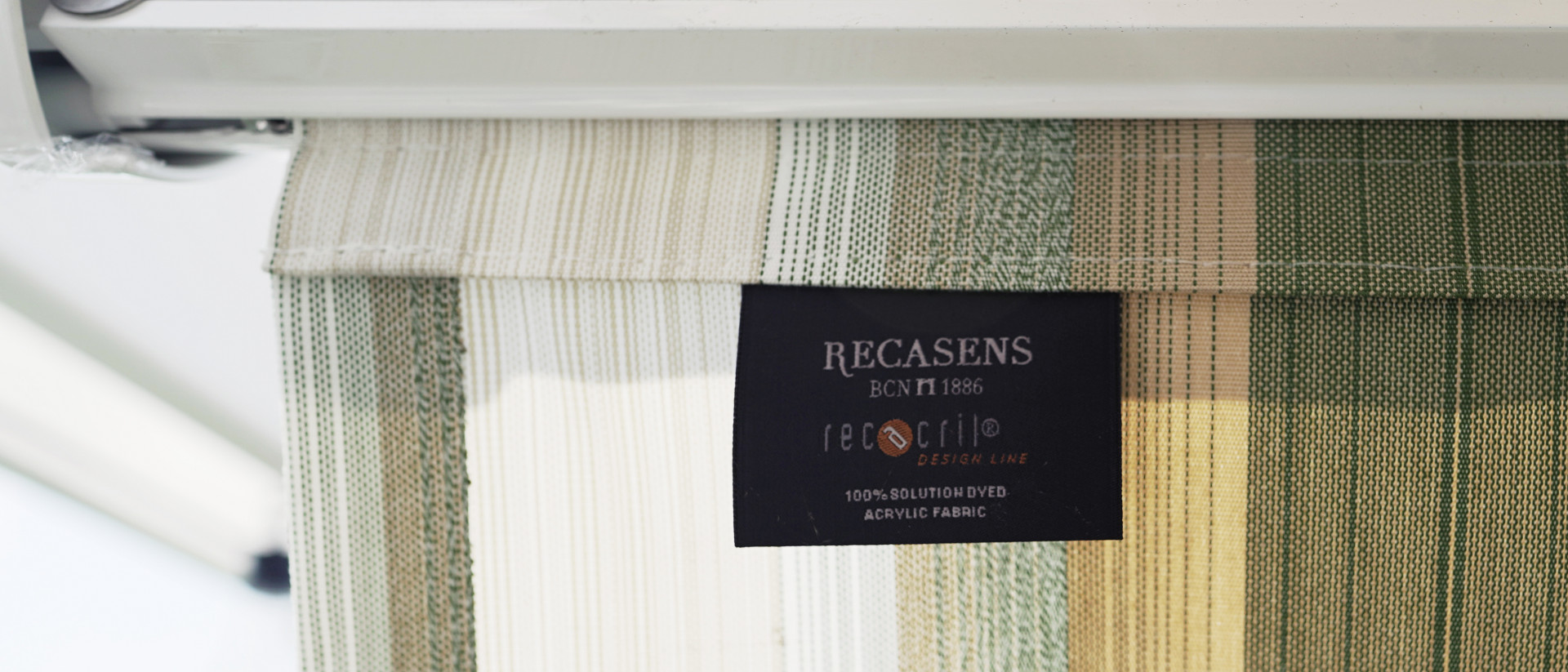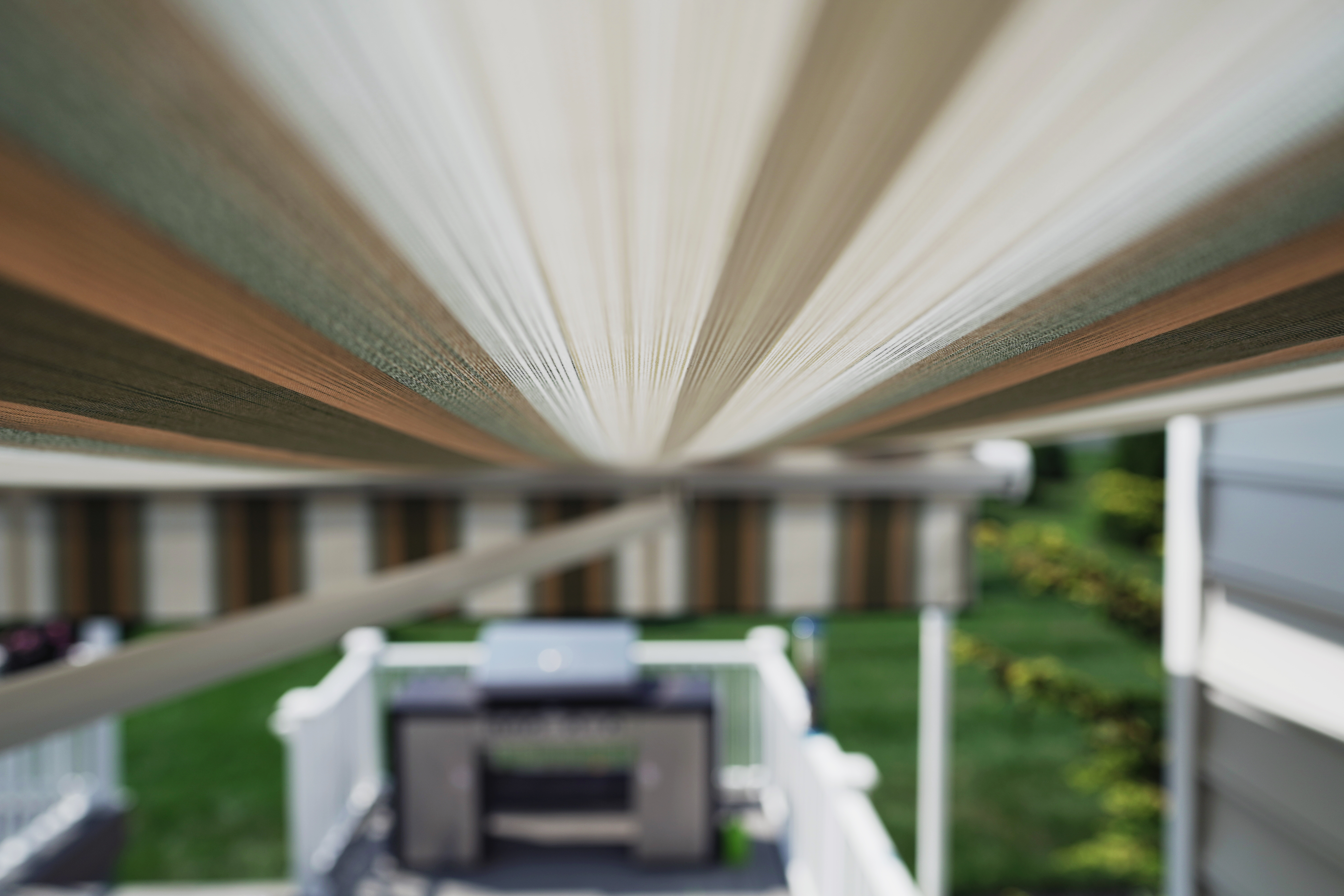Types of Fabric for Retractable Awnings
There are so many choices when it comes to retractable awning fabrics, but this is a good problem to have!

The part of the world you live in will be a major factor in deciding on an awning fabric, as some are resistant to fading, mold growth, and other damage that may be caused by the elements. Other factors that go into the choice include color and pattern, durability, stain resistance, and warranty. We carry the industry’s top fabrics, which offer superior color saturation, UV protection, and damage resistance.
Solution-dyed acrylic
Solution-dyed acrylic has many properties that make it the ideal fabric for outdoor retractable awnings. The manufacture of this fabric starts with fibers that have been solution dyed, meaning that the fibers receive their dyes when they are still in liquid form -- well before they are fabricated into yarn or cloth. The color of this fabric is persistent throughout the cloth, not just on the surface. This means that they retain their color better than almost any other fabric in the face of UV light and weather exposure.
Also, unlike coating-based awning fabrics, acrylic is soft to the touch rather than smooth and plastic-y, making them more amenable to residential style than their coating-based counterparts. At the same time, they offer high resistance to water, resist shrinkage, and require no special cleaners. There really aren't downsides to this type of fabric.
Recognizable brands that offer solution-dyed acrylic fabrics include Sunbrella, RECacril, Para Tempotest, and Sattler. All of these brands are highly rated for sun protection, and while they look great, they are manufactured to be easy to care for.
Solution-dyed acrylic is a relatively recent innovation in the outdoor fabric industry, and it is so superior to alternatives, we don't recommend or offer any other types of fabric for use in retractable awnings. To fully understand why, though, we will go through common alternatives.

Vinyl
Vinyl is a synthetic hybrid material that is made from ethylene and chlorine. Due to its durability, cost, and water resistance, vinyl finds its use in many construction materials such as siding and flooring. Vinyl is used as a material for awnings for numerous reasons. Vinyl is low maintenance and can withstand weather and sun. It does not collect dirt and stains nor does it grow mold, and it can be easily hosed free of dirt.
However, vinyl may tear in windy conditions more easily than acrylic or other options. It is also manufactured in a limited range of colors and patterns, so you may have trouble finding exactly what you want. Another con of vinyl awnings is their structure: the fabric’s many layered construction is less breathable than other fabrics and may trap heat and humidity more readily.
Due to the thickness and inflexibility of vinyl, we do not use it in retractable awnings. However, its complete water resistance and durability make it an excellent option for other types of awnings, and you will see it as an option throughout much of the Humphrys product line.
Polyester
Like other synthetic materials, polyester has the advantage of being mold resistant, easy to clean, and fade resistant. Polyester awnings do a good job of blocking UV rays and will maintain their color and pattern even after years of baking in the sun. However, polyester is not the optimal material to protect you and your deck from rain and water, so these awnings will not be useful in light rain.
While you will find polyester on many budget awning offerings, Humphrys Awnings does not offer it as an option on any of our products. This is simply because any initial cost savings over solution-dyed acrylic do not outweigh the downsides of reduced water resistance and higher long-term maintenance costs.
Canvas
Canvas used to be very commonly used in awnings of all types, before synthetic alternatives became available. It is made from woven fabric such as cotton, linen, or hemp. As these are natural fibers, canvas is susceptible to the effects of moisture and can easily grow mildew and mold. This also means that colored canvas fades more quickly than others when exposed to the sun. While there are protectants that can effectively treat canvas awning fabric, they need to be reapplied regularly.
While more expensive, awnings made of heavy canvas fabric provide reasonable resistance to the wind and can accommodate the weight of snow accumulation. However, a retractable awning should be and can easily be retracted in the weather, so these are not qualities that are highly valued in a retractable awning. Given their extra expense and lack of adaptability to the elements, canvas is not a fabric that we recommend for retractable awnings.
Cotton
While cost-effective, cotton is not an ideal fabric for retractable awnings. It is highly susceptible to moisture and fading, and so is completely unsuitable for wet, humid climates. While cotton cloth made for outdoor use is coated for durability and water resistance, it is still more vulnerable to fading and mildew than alternatives. While you may save some money going with a cotton cover initially, maintenance and replacement costs will quickly outweigh any initial savings.